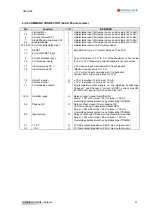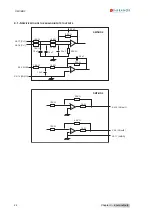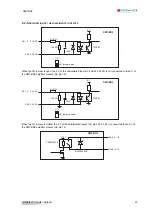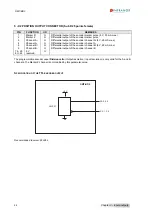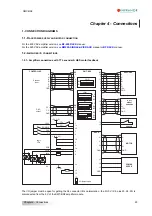
SMT-BD2
1.
3
-
H
ALL
E
FFECT
S
ENSORS CONFIGURATION
If the motor is equipped with Hall Effect Sensors devices (HES), select the following COM jumpers setting
according to the HES type (60° or 120°).
B5
B4
COM
B3
B5
B4
COM
B3
60
°
HES type
120
°
HES type
If the motor is not equipped with Hall Effect Sensors devices, the following COM jumpers setting must be
selected. In this case a motor phasing procedure must be executed at each amplifier power up.
B5
B4
COM
B3
1.
4
-
M
OTOR THERMAL SENSOR CONFIGURATION
Select the right MN or OP jumper setting according to the motor thermal sensor type (PTC or NTC).
1.4.1 - PTC thermal sensor
On motors equipped with a PTC thermal sensor (triggering on high impedance), the amplifier configuration is the
following: MN jumper closed and OP jumper open. The triggering threshold adjustment for the PTC thermal
sensor is made by means of the PSTH components, as described below : PSTH-D = 14,3 k
Ω
; PSTH-B = 28 k
Ω
;
PSTH-A = 3 x RPTC (120°C) in k
Ω
. RPTC (120°C) = ohmic value of the PTC thermal sensor resistor at 120°C;
the default adjustment is RPTC (120°C)
#
3 k
Ω
with PSTH-A = 10 k
Ω
.
1.4.2 - NTC thermal sensor
On motors equipped with a NTC thermal sensor (triggering on low impedance), the amplifier configuration is the
following: OP jumper closed and MN jumper open. The triggering threshold adjustment for the NTC thermal
sensor is made by means of the PSTH components, as described below: PSTH-D = 14,3 k
Ω
; PSTH-B = 28 k
Ω
;
PSTH-A = 3 x RNTC (120°C) in k
Ω
. RNTC (120°C) = ohmic value of the NTC thermal sensor resistor at 120°C;
the default adjustment is RNTC (120°C)
#
3 k
Ω
with PSTH-A = 10 k
Ω
.
35
Chapter 6 - Commissioning

